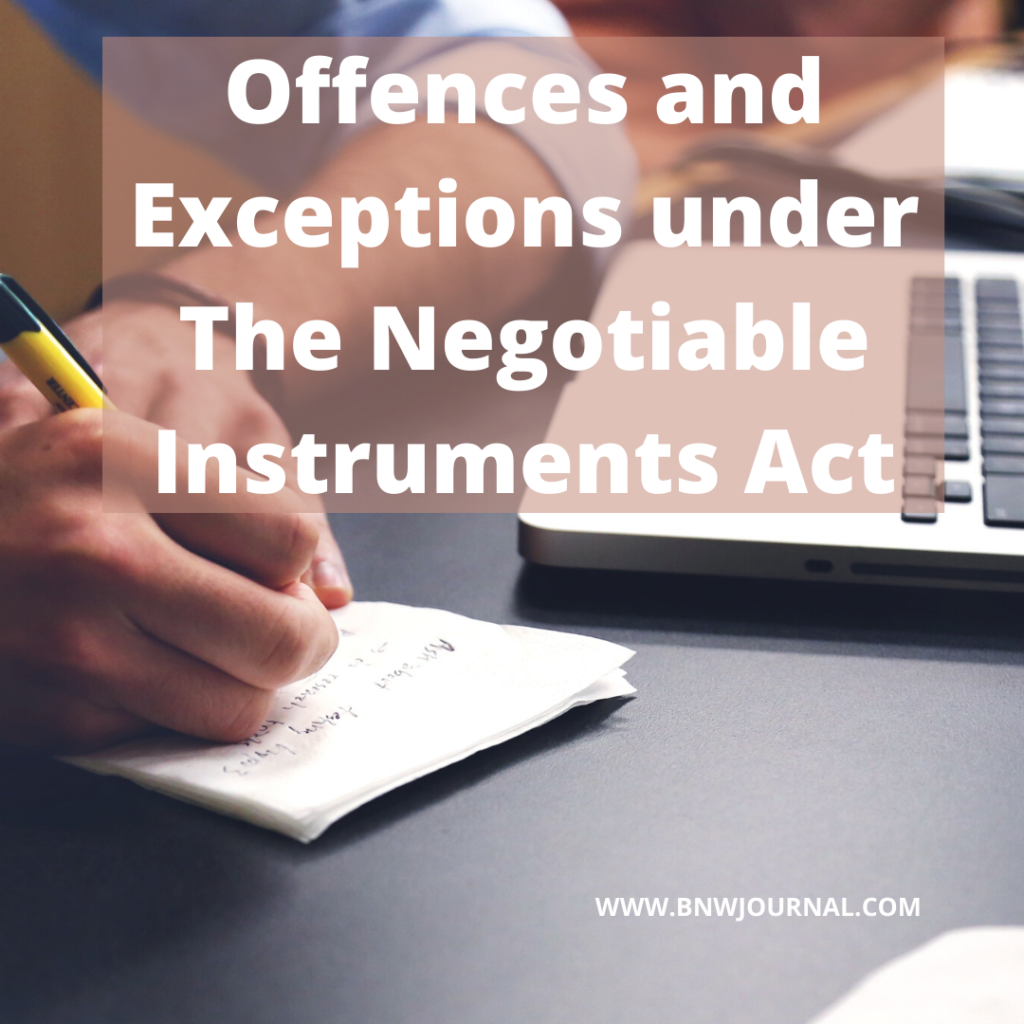![]()
Introduction
A Negotiable Instrument authorises a person to transfer his sum of money to another by way of delivery or endorsement. The person to whom the money is transfer is further transferable to another person. Negotiable instruments plays a vital role in trading. The person who is entitle to the sum is regard as the true owner of the instrument. However, such right is transferred solely after complete delivery of the instrument. The legal definition of the term has been specified under Section 13(i) which defines a “negotiable instrument” as a promissory note, bill of exchange or cheque, payable to order or bearer. No specific obligations or conditions are imposed on the bearer for receiving the monetary amount stated in the instrument.

Types of Negotiable Instruments
There are various types of Negotiable Instruments. They are as under:
I. Promissory Notes:
A promissory note under Section 4 of the Act is define as:
a. an instrument in writing
b. not being a banknote or a currency
c. containing an unconditional undertaking
d. Signed by the maker,
e. to pay a certain sum of money and money only
– to a certain person
– Also to the order of a certain person, or
– to the bearer of the instrument.
II. Bills of Exchange:
A bill of exchange under Section 5 of the Act is defined as:
a. an instrument in writing
b. containing an unconditional order
c. signed by the maker
d. directing a certain person
e. to pay a certain sum of money and money only
– to a certain person, or
– to the order of a certain person, or
– And to the bearer of the instrument.
III. Cheques
A cheque under Section 6 of the Act is defined as:
A bill of exchange which is drawn on a specified banker (that is a bank) and is not express to be payable otherwise than on demand. The term also includes the electronic image of a truncated cheque and a cheque in an electronic form.
Characteristics of Negotiable Instruments
The characteristics of Negotiable Instruments are as under:
Freely transferrable: In a negotiable instrument, the transfer if payable to the bearer, is by mere delivery or endorsement.
Recovery: One can sue upon the delivery in his own name.
Title of the holder is free from all defects: In the title of the transferor, the person to whom the instrument is deliver shall receive the same without any defects.
Presumption: Negotiable Instruments consists of certain presumptions unless the contrary is provided:
- Consideration
- Date
- Time of acceptance
- Time of transfer
- Transferred for consideration
- Order of endorsements
- Stamp
- Holder in due course
- Proof of protest
Offences and Exceptions under the Act
I. Section 138: Dishonour of Cheque for insufficiency of funds
The object of this particular Section fosters the banking operations and ensures effectiveness in business transactions by way of cheque. Likewise, all the Sections upto Section 142 of the Act have the same object. The Section hurls a criminal liability that is punishable with imprisonment upto 2 years or fine which may extend to twice the amount of the cheque or both on a person who issues a cheque towards discharge of a debt or liability as a whole or in part and the cheque is dishonour by the bank on presentation. Such an offence shall be non-cognizable, bailable and compoundable.
For instance, A and B own a registered partnership firm of interior designing. C, the owner of a clothing shop appoints their firm for the interior of his shop for an amount of Rs. 3 Lakhs as professional fees. On completion of work, C hands over a cheque of ICB Bank amounting to Rs. 3 Lakhs to A and B. However, when the cheque is present by them in their SFI Bank, the same is return with the remark, “funds insufficient”. On receipt of the same, the partners try to coordinate with C but, receive no response. In such a case, the partners are entitle to take necessary legal action. There can be many reasons for dishonour of cheque such as, stop payment, closure of bank account, post-dated cheque, refer to the drawer, not a clearing member, etc funds insufficient is the most commonly occur reason under the same.
Offences under the Section:
- The cheque should be presented in the drawee’s bank within a period of six months or the expiry of the cheque, whichever is earlier.
- In case the drawee wants to send a legal notice then the same should be within a period of 15 days from the date of receipt of such remark from the Bank.
- If the drawer fails to make payment of the amount within a period of 15 days from the date of receipt of such notice, the drawee has the right to file a petition before the Court under Section 138 of the Negotiable Instruments Act.
Exception under the Section:
In the case of Thirumala Agencies And Another vs Samala Mareppa And Sons, the Karnataka High Court held that
“ If the cheque came to be present, and it was return with an endorsement “account close” it amounts to dishonesty and it comes within the definition of Section 138 of the NI Act and thereby resulted in the dishonour of cheque. To add further, it can be said that the cheque was issued with an intention of defrauding the creditors.
Therefore, the contention of the learned Counsel that the ‘account closed’ does not come within the ingredients of Section 138 of the NI Act cannot be accepted. It is clear from the meaning of Section 138 of the NI Act that if a cheque is issued and bounced, that gives rise to initiation of proceedings under Section 138 of the NI Act. Therefore, I do not find any infirmity in presenting a complaint for initiation of the action under Section 138 of the NI Act wherein the Court has taken cognizance in accordance with law.”
Hence, this Section is not applicablein case the account has been closed before the cheque bounces.
Section 139: Presumption in favour of the holder
Under this Section, it shall be presume that the drawer has violate the provisions under section 138 of the Act. Unless and until the contrary is prove. This means that the accused is presumed to be guilty until his innocent is proved hence the burden of proof lies on the accused.
III. Section 140: Non-allowance of defence
This Section prohibits what cannot be consider as a defence by the prosecution with regard to the offence under Section 138 of the Act. If the cheque was give by the drawer to the drawee as security, then the drawee’s defence shall be consider to be irrelevant as there was no liability on behalf of the drawer.
IV. Section 141: Offences by Companies
This Section states that if the drawer who has violate the provisions under Section 138 of the Act falls under the definition of a company when the offence was commit or was responsible for any businesses carry on by the company, shall be presume to be guilty and punish. However, there are certain exceptions of this Section which are as under:
Exceptions under the Section
- If the company proves that on gaining knowledge regarding the offence, it had taken all the necessary precautions for prevention of any such violations.
- If the company proves that it was unaware of any such activity or had no knowledge regarding the same.
- However, if the company fails to prove its innocence under the above two categories. The offence shall be deem to be commit with full consent of the members of that particular company.
- Not every director shall be deem to have commit any offence under the Section. Unless he was found to be in charge for conducting such business.
V. Section 142: Cognizance of Offences
This Section states that the court cannot take cognizance of an offence. Unless a complaint is by the drawee. Hence a legal notice must be send to the drawer before filing of complaint before the Court.
Conclusion
The provisions of this Act, particularly of the above Sections are enact in order to safeguard the right of the drawee from the drawer who is liable to make full payment to the drawee in lieu of consideration. This Act not only protects the interest of the drawee but also helps in a well ordered system of bills of exchange.



0 Comments